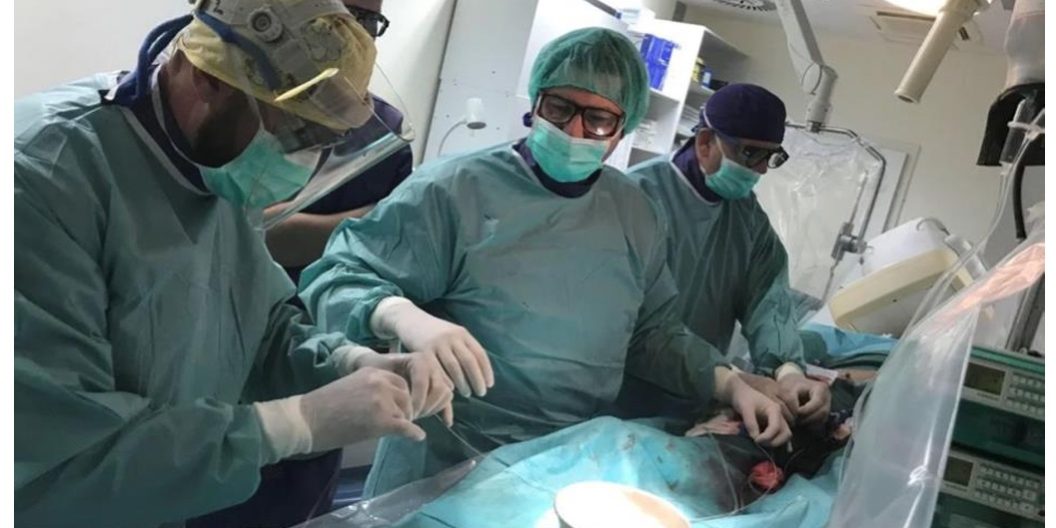The Neurosurgery Clinic at the University Clinical Center Tuzla celebrated the landmark achievement of conducting its 1000th endovascular treatment for intracranial aneurysms. This minimally invasive procedure represents a significant advancement in the management of brain aneurysms.
This milestone reaffirms the University Clinical Center Tuzla’s unequivocal leadership in Bosnia and Herzegovina’s endovascular neurosurgery domain. Not only is it the sole institution in the country to sustain uninterrupted endovascular neurosurgery procedures for over a decade, but it also boasts the highest volume of such procedures performed.
At the University Clinical Center Tuzla, patients from across Bosnia and Herzegovina receive endovascular treatment for severe vascular diseases affecting the brain and spinal cord. These conditions include intracranial aneurysms, arteriovenous malformations (AVMs), intracranial and spinal dural arteriovenous fistulas, carotid artery stenosis, vertebral basilar artery stenosis, hypervascular intracranial tumors, and more recently, acute ischemic strokes resulting from occlusion of major arteries.
These complex procedures are carried out by specialized neurosurgeons and medical radiology engineers and technicians from the Clinic for Radiology, the University Clinical Center Tuzla, with invaluable support and collaboration from the medical team at the Clinic for Anesthesiology and Reanimation.
As explained by Assoc. Prof. Mirza Moranjkić, a key member of the endovascular neurosurgical team and the head of the Clinic for Neurosurgery, Tuzla neurosurgeons distinguish themselves from regional norms by providing comprehensive care for brain vascular diseases. This includes the integration of minimally invasive endovascular treatments and microsurgical interventions for intracranial aneurysms within a single institution. Unlike practices in other centers, our approach eliminates the competitive dynamics among specialists, ensuring cohesive and patient-centric care delivery.
This approach ensures patients receive treatment tailored to their individual needs, taking into account factors such as the size, location, and morphology of the aneurysm. Tuzla neurosurgeons have undergone extensive training in renowned centers across Europe to master these procedures. Their expertise is further enhanced by the comprehensive and specialized education done by Assoc. Prof. Mirza Moranjkić and Dr. Gordan Mehmedović at the Clinic for Neurosurgery and Interventional Neuroradiology in Deggendorf, Germany, adding a distinct level of credibility to their practice.
“Among the myriad technically challenging procedures conducted over the years, singling out a single procedure proves difficult. However, there’s always a profound sense of fulfillment when helping a young patient. Recently, our team undertook an exceptionally complex vascular procedure for a pediatric patient, which makes us particularly proud.” said Dr. Gordan Mehmedović, specialist in neurosurgery and Dr. Amir Sejdinović, doctors who daily perform the most intricate endovascular neurosurgical interventions.
The operational team, led by Dr. Morankić, Dr. Mehmedović , and Dr. Sejdinović, comprises additional neurosurgeons from the Clinic for Neurosurgery, along with medical radiology engineers Senad Šadić, Damir Alić, and Mirza Jahić. They are supported by experienced instrument technicians under the guidance of Svjetlana Beganović Trgovčević. Furthermore, the team includes experienced anesthesiologists and anesthetists from the Clinic for Anesthesiology and Reanimation at the University Clinical Center Tuzla. Their profound knowledge and expertise in neuro-anesthesia have been pivotal in ensuring the safe execution of this highly sophisticated form of treatment for complex neurosurgical conditions for over a decade.
“The endovascular neurosurgery project at the University Clinical Center Tuzla is an excellent example of collaboration among clinical departments, notably the Clinic for Neurosurgery, the Clinic for Radiology and Nuclear Medicine, and the Clinic for Anesthesiology and Reanimation. I am particularly gratified by the recent initiative by the Clinic for Neurology, focusing on systematic protocol development for mechanical thrombectomy following stroke. While our clinic has performed this procedure for many years, a standardized protocol in collaboration with the Clinic for Neurology promises expanded access to its benefits for a wider patient population,” concluded Assoc. Prof. Morankić.







